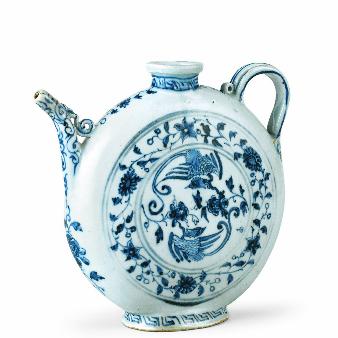
20.
EWER
WHITE PORCELAIN DECORATED IN UNDERGLAZE BLUE
JINGDEZHEN KILNS, JIANGXI PROVINCE
YUAN DYNASTY (1279–1368), 14TH CENTURY
HEIGHT 21.7 CM; MOUTH DIAMETER 18.5 CM;
FOOT DIAMETER 5.8 CM
INV. NO. 215
Ewer with spherical, flattened body, resting
on an oval foot; a short, narrow neck with
flared, rounded lip; small, slightly curved
spout, attached to the shoulder by a scrolling
bridge; the looped, curved handle with two
grooved lines and a leaf at the base, with a
ring on the central rib next to the shoulder.
Made of porcelain in two symmetrical parts,
covered with heavy, greyish glaze, except for
the foot ring, which turned orange when
fired.
The underglaze blue decoration was painted
in tones that vary from almost black to
greyish. On each side a large circular panel,
enclosing another smaller panel, both framed
by double concentric circles. The inner
reserve contains two phoenixes flying in
clockwise direction with their heads turned
towards their tails, separated by two
chrysanthemums on one side and two
peonies on the other; both are surrounded by
a scroll of alternating chrysanthemum and
pomegranate flowers. Above and below the
handle and the spout a chrysanthemum
spray and a peony spray, respectively.
A key fret border around the foot and neck, a
foliate scroll on the spout. The moulding of
the handle and the spout is accentuated by
blue lines.
The main decorative theme is the phoenix,
‘the emperor of birds’, which presides over
the southern quadrant of the heavens and
therefore symbolizes the sun and the heat of
summer and autumn.
Earthenware ewers similar in form and
design to this were made at the end of the
eleventh century, during the Liao dynasty
(907-1125), as for example, the ewer in
sancai
palette glazes in the Tsui Museum of
Art in Hong Kong. 1
A ewer of the same shape but with
differences in the spout (which is shaped like
a phoenix head), in the handle, and in the
decoration (which illustrates a phoenix and a
lotus blossom) was excavated in October
1970 from ruins dating from the Yuan
dynasty on Drum Tower Street in Beijing and
is now in the Beijing Cultural Relics Office. 2
Nuno de Castro published a ewer identical to
this example. 3
1 The Tsui Museum of Art, 1993, no. 154.
2 Li Zhiyuan and Cheng Wen, 1996, pp. 125, 208, no. 126.
3 Castro, 1992, vol. I, p. 200, no. 164.
54 .
PORCELAIN OF THE YUAN (1279–1368) AND MING (1368–1644) DYNASTIES